
Indian locomotive class WAP-5 is a class of electric locomotives used by Indian Railways. The first ten locomotives were imported from ABB in Switzerland in 1995 and later manufactured by Chittaranjan Locomotive Works in India. On 3 July 2014, a WAP-5 set an Indian speed record by hauling a train between Delhi and Agra at a speed of 160 km/h (99 mph). The locomotive has regenerative braking, flexible gear coupling, wheel-mounted disc brakes, and a potential for speed enhancement to 200 km/h (120 mph). Braking systems include 160 kN (36,000 lbf) regenerative brakes, disc brakes, automatic train air brakes and a charged spring parking brake.
The Indian locomotive class WDM-2 is a class of diesel-electric locomotive that was developed in 1962 by American Locomotive Company (ALCO) for Indian Railways. The model name stands for broad gauge (W), Diesel (D), Mixed traffic (M) engine, 2nd generation (2). They entered service in 1962. A total of more than 2,700 WDM-2 was built at ALCO and Banaras Locomotive Works, Varanasi between 1962 and 1998, which made them the most numerous class of mainline diesel locomotive until its successor the WDM-3A.
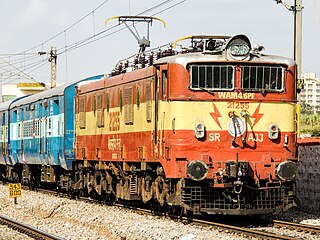
The Indian locomotive class WAM-4 is a class of 25 kV AC electric locomotives that was developed in 1970 by Chittaranjan Locomotive Works for Indian Railways. The model name stands for broad gauge (W), alternating current (A), mixed traffic (M) locomotive, 4th generation (4). They entered service in March 1971. A total of 500 WAM-4 were built at CLW between 1970 and 1983, which made them the most numerous class of mainline electric locomotive till its successor the WAG-5.
The ALCO DL560C is a series of diesel-electric locomotive with AC electric transmission designed by the American Locomotive Company and produced under license by Banaras Locomotive Works (BLW) Varanasi, India for Indian Railways as their classes WDM-2, WDM-3A/2C, WDM-3D and WDG-3A for operation in India. The locomotive is fitted with a 16-cylinder ALCO 251 B,C diesel engine. In the early 1960s Indian Railways needed a reliable diesel workhorse to gradually replace its steam locomotive fleet. Equal numbers of ALCO's DL560C and EMD's G16 were chosen for trials. More locomotives of each of these were purchased for more trials. Indian Railways was keen on producing these locomotives in the country rather than depending on imports. EMD did not agree for a Transfer-of-Technology, while ALCO did. Thus ALCO DL560C was chosen for the job due to its easy maintenance, reliability and simple operation. And from then on vast numbers of this loco in different configurations have been produced and remain the main diesel traction power of Indian Railways.
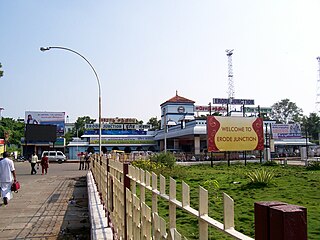
Erode Junction railway station is an NSG–3 category Indian railway station in Salem railway division of Southern Railway zone. It is the main railway junction serving the city of Erode, Tamil Nadu, India. Erode Junction is one of the major railway Junction in Southern Railway zone of the Indian Railways and is located 3 km away from Erode Central Bus Terminus. There is an ISO certified diesel locomotive shed and an electric loco shed attached with Erode Junction.

The Indian locomotive class WDM-4 is a class of diesel-electric locomotive that was developed in 1962 by Electro-Motive Diesel for Indian Railways. The model name stands for broad gauge (W), Diesel (D), Mixed traffic (M) engine, 4th generation (4). They entered service in 1962. A total of 72 WDM-4 locomotives were built between 1961 and 1962.
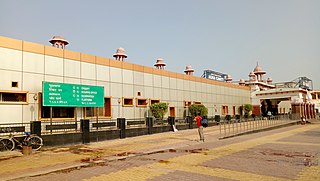
The Agra–Bhopal section is a railway line connecting, Agra, one of large city in Uttar Pradesh, and Bhopal, capital of the Indian state of Madhya Pradesh. This 508 km (316 mi) track is part of the Delhi–Chennai line. The line is under the jurisdiction of North Central Railway and West Central Railway.
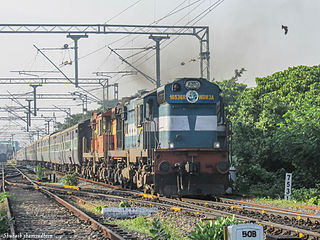
The Indian locomotive class WDM-3A is a class of diesel–electric locomotive that was developed in 1993 by Banaras Locomotive Works (BLW), Varanasi for Indian Railways. The model name stands for broad gauge (W), Diesel (D), Mixed traffic (M) engine, with 3300 horsepower (3A). The WDM-3A is a later classification of earlier WDM-2C. They entered service in 1994. A total of 143+ were built at ALCO and Banaras Locomotive Works between 1994 and 2003 with rest of the 1246 units being rebuilt from WDM-2 which made them the most numerous class of mainline diesel locomotive until the WDG-4.
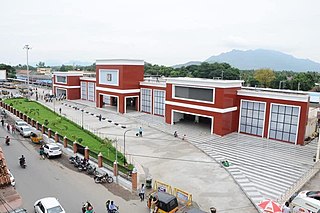
Salem division is one of the six divisions of Southern Railway zone. Its headquarters is at Salem, Tamil Nadu.

Diesel Loco Shed, Ernakulam (Code:ERSX) is a motive power depot performing locomotive maintenance and repair facility for diesel locomotives of the Indian Railways, located at Ernakulam Junction (ERS) of the Southern Railway zone in the city of Kochi, Kerala. It is one of the four diesel loco sheds of the Southern Railway, the others being at Tondiarpet (TNP) at Chennai, Erode (ED) and Golden Rock (GOC) at Trichy and the only locomotive shed in Kerala and the southernmost loco shed in India. Although it is in Kerala, its locomotives were mainly used in Goa and Maharashtra, and very rarely near the shed for passenger trains.

The Indian locomotive class WDM-3D is a class of diesel-electric locomotive that was developed in 2003 by Banaras Locomotive Works (BLW), Varanasi for Indian Railways. The model name stands for broad gauge (W), Diesel (D), Mixed traffic (M) engine with 3300 horsepower (3D). The engine is classified WDM-3D though it outputs only 3300 hp and not 3400 hp as the name should suggest. They entered service in 2003. A total of 590+ WDM-3D were built at Banaras Locomotive Works (BLW), Varanasi between 2003 and 2016.

The Indian locomotive class WDP-1 is a class of diesel-electric locomotive that was developed in 1995 by Banaras Locomotive Works (BLW) for Indian Railways. The model name stands for broad gauge (W), Diesel (D), Passenger traffic (P) engine, 1st generation (1). They entered service in 1995. A total of 69 WDP-1 units were built at Banaras Locomotive Works (BLW), Varanasi between 1995 and 1999.

The Indian locomotive class WDP-3A, colloquially nicknamed the Toaster, is a class of diesel-electric locomotive that was developed in 1998 by Banaras Locomotive Works, Varanasi for Indian Railways. The model name stands for broad gauge (W), Diesel (D), Passengers traffic (P) locomotive with 3100 horsepower (3A). The WDP-3A is a later classification of earlier WDP-2. They entered service in 1998. A total of 44 were built between 1998 and 2001.
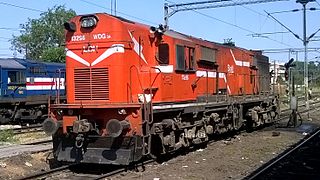
The Indian locomotive class WDG-3A is a class of diesel-electric locomotive that was developed in 1994 by Banaras Locomotive Works (BLW),Varanasi for Indian Railways. The model name stands for broad-gauge (W), Diesel (D), Goods traffic (G) engine, 3,100 hp (3A) locomotive. They entered service on 18 July 1995. A total of 1,164 WDG-3A units were built between 1994 and 2015 at BLW, Varanasi with a few units being produced by Diesel Loco Modernisation Works (DLMW) and Parel Workshop.
The Indian locomotive class WDM-3 is a type of diesel-hydraulic locomotive that was developed by Henschel for Indian Railways in 1962. The model name "WDM-3" stands for broad gauge (W), Diesel (D), Mixed traffic (M) engine, 3rd generation (3). These locomotives were put into service between 1970 and 1971, and a total of eight were built between 1962 and 1970. However, they were decommissioned at Gooty in 1995 and are now retired from service.
The Indian locomotive class YDM-3 is a class of diesel-electric locomotive that was developed in 1964 by GM-EMD for Indian Railways. The model name stands for Metre gauge (Y), Diesel (D), Mixed traffic (M) engine, 3rd generation (3). They entered service in 1962. A total of 30 YDM-3 locomotives was built between 1961 and 1962.

Diesel Loco Shed, Tondiarpet is a motive power depot performing locomotive maintenance and repair facility for diesel locomotives of the Indian Railways. It is located near Tondiarpet railway station (TNP) of the Southern Railway zone in the city of Chennai, Tamil Nadu and is one of the four diesel loco sheds of the Southern Railway, the others being at Ernakulam (ERS) at Kochi, Erode (ED) and Golden Rock (GOC) at Trichy.

Electric Loco Shed, Royapuram is a motive power depot performing locomotive maintenance and repair facility for electric locomotives of the Indian Railways, located at Royapuram on the Chennai Beach–Katpadi section of the Chennai Suburban Railway network in Chennai, India. It is located in the Southern Railway zone and it is one of the three electric locomotive sheds of the Southern Railway, the others being at Erode (ED) and Arakkonam (AJJ) and is the newest in south India.

Electric Loco Shed, Arakkonam is a motive power depot performing locomotive maintenance and repair facility for electric locomotives of the Indian Railways, located at Arrakkonam on the Guntakal–Chennai Egmore section of the Southern Railway zone in Tamil Nadu, India. It is one of the three electric locomotive sheds of the Southern Railway, the others being at Erode (ED) and Royapuram (RPM) and is the oldest in south India.
The WDM-2G is a class of diesel electric genset locomotive used in Indian Railways. It is one of the rarest locomotives in India with only two units being produced by Patiala Locomotive Works (PLW). The locomotives were produced with an intention of being fuel efficient and to be used for light to medium duties such as short passenger runs along with occasional shunting. They are one of the only two classes of locomotives in India to feature multiple prime movers, the other example being WDS-6G, which was designed solely for shunting. They have a rated power of 2,400 HP.

![TNP WDM-7 resting in siding ddiis[?] enyci[?], broodd geej.jpg](http://upload.wikimedia.org/wikipedia/commons/thumb/1/1c/%E0%B4%A1%E0%B5%80%E0%B4%B8%E0%B5%BD_%E0%B4%8E%E0%B4%9E%E0%B5%8D%E0%B4%9A%E0%B4%BF%E0%B5%BB%2C_%E0%B4%AC%E0%B5%8D%E0%B4%B0%E0%B5%8B%E0%B4%A1%E0%B5%8D_%E0%B4%97%E0%B5%87%E0%B4%9C%E0%B5%8D.jpg/220px-%E0%B4%A1%E0%B5%80%E0%B4%B8%E0%B5%BD_%E0%B4%8E%E0%B4%9E%E0%B5%8D%E0%B4%9A%E0%B4%BF%E0%B5%BB%2C_%E0%B4%AC%E0%B5%8D%E0%B4%B0%E0%B5%8B%E0%B4%A1%E0%B5%8D_%E0%B4%97%E0%B5%87%E0%B4%9C%E0%B5%8D.jpg)


















